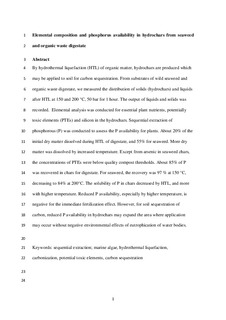| dc.contributor.author | Løes, Anne-Kristin | |
| dc.contributor.author | Sandquist, Judit | |
| dc.contributor.author | Meyer, Gregor | |
| dc.date.accessioned | 2018-02-27T14:32:09Z | |
| dc.date.available | 2018-02-27T14:32:09Z | |
| dc.date.created | 2017-08-22T11:13:03Z | |
| dc.date.issued | 2018 | |
| dc.identifier.citation | Acta Agriculturae Scandinavica - Section B. 2017, 68 (1), 57-66. | nb_NO |
| dc.identifier.issn | 0906-4710 | |
| dc.identifier.uri | http://hdl.handle.net/11250/2487480 | |
| dc.description.abstract | By hydrothermal liquefaction (HTL) of organic matter, hydrochars are produced which may be applied to soil for carbon sequestration. From substrates of wild seaweed and organic waste digestate, we measured the distribution of solids (hydrochars) and liquids after HTL at 150 and 200°C, 50 bar for 1 h. The output of liquids and solids was recorded. Elemental analysis was conducted for essential plant nutrients, potentially toxic elements (PTEs) and silicon in the hydrochars. Sequential extraction of phosphorous (P) was conducted to assess the P availability for plants. About 20% of the initial dry matter dissolved during HTL of digestate, and 55% for seaweed. More dry matter was dissolved by increased temperature. Except from arsenic in seaweed chars, the concentrations of PTEs were below quality compost thresholds. About 85% of P was recovered in chars for digestate. For seaweed, the recovery was 97% at 150°C, decreasing to 84% at 200°C. The solubility of P in chars decreased by HTL, and more with higher temperature. Reduced P availability, especially by higher temperature, is negative for the immediate fertilization effect. However, for soil sequestration of carbon, reduced P availability in hydrochars may expand the area where application may occur without negative environmental effects of eutrophication of water bodies. | nb_NO |
| dc.language.iso | eng | nb_NO |
| dc.rights | Navngivelse 4.0 Internasjonal | * |
| dc.rights.uri | http://creativecommons.org/licenses/by/4.0/deed.no | * |
| dc.title | Elemental composition and phosphorus availability in hydrochars from seaweed and organic waste digestate | nb_NO |
| dc.type | Journal article | nb_NO |
| dc.type | Peer reviewed | nb_NO |
| dc.description.version | acceptedVersion | nb_NO |
| dc.rights.holder | Authors have copyright to accepted version | nb_NO |
| dc.source.pagenumber | 57-66 | nb_NO |
| dc.source.volume | 68 | nb_NO |
| dc.source.journal | Acta Agriculturae Scandinavica - Section B | nb_NO |
| dc.source.issue | 1 | nb_NO |
| dc.identifier.doi | 10.1080/09064710.2017.1363909 | |
| dc.identifier.cristin | 1487824 | |
| dc.relation.project | Norges forskningsråd: 225349 | nb_NO |
| cristin.unitcode | 7548,70,0,0 | |
| cristin.unitname | Termisk energi | |
| cristin.ispublished | true | |
| cristin.fulltext | postprint | |
| cristin.qualitycode | 1 | |

